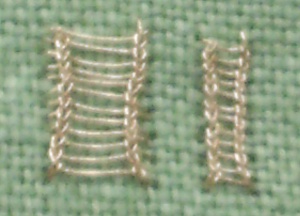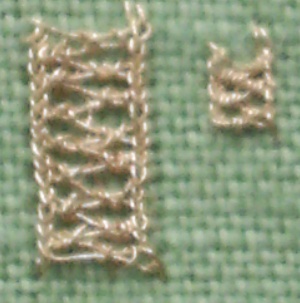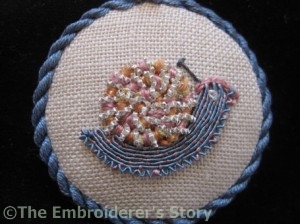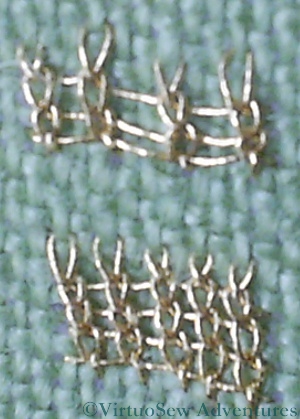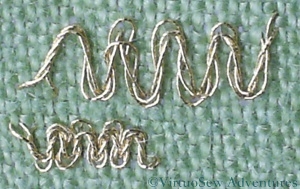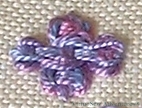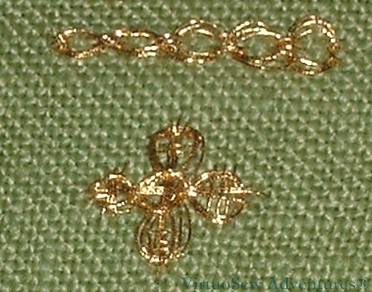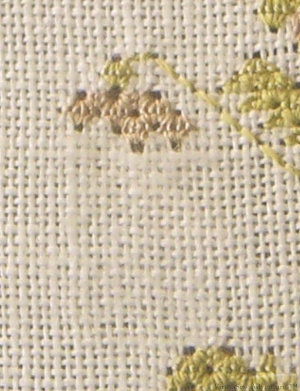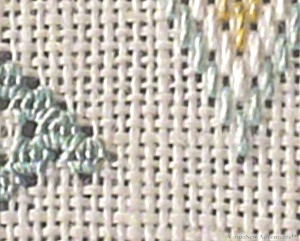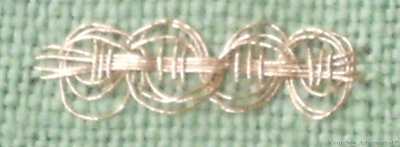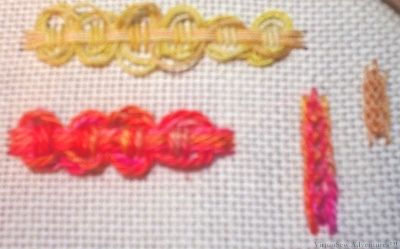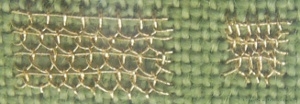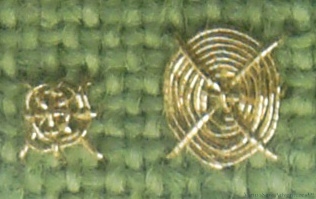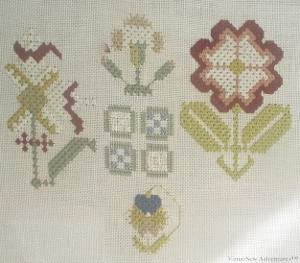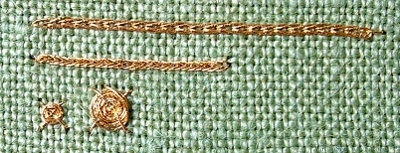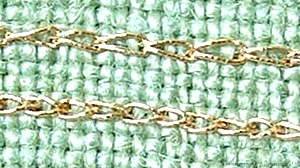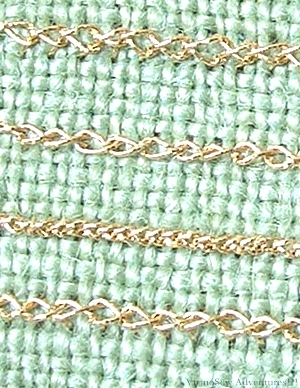Category: Tudor and Stuart Gold Master Class
Tudor and Stuart Goldwork Masterclass Stitches – Month Eight
This month Tricia’s History and Analysis section includes a description from the animator of how he approaches animating the stitches. It’s very painstaking work, and as the first thing he does is to follow the instructions just as we are, he is going to end the course with the same repertoire of exotic stitches as we have!
The first of this month’s stitches is Ladder stitch. Like last month’s Ceylon Stitch, this is a stitch I have worked before; in fact it’s very like Ceylon Stitch in structure as well. I can change the width of the stitch, but not the vertical scale, so my two versions here look very similar. With the rather stiff gold thread, the stitch becomes rather a trial when worked with long “rungs”, so I enjoyed it more when I worked it in a narrower space.
The second stitch is an embellishment of Ladder Stitch, using a ZigZag whipping. I had trouble with this stitch because I simply couldn’t bring myself to pull the whipping tight, so it tangled and tied itself up, and nearly tied me up with it. As the shorter version shows, once I sorted myself out, the stitch sorted itself out too.
My problem is that I’m very aware of the way the thread is made, and concerned that the wrapping of metallic foil will be broken if I pull too tight. It isn’t really a problem, as the overall effect of the thread usually masks any slight breaks, but try telling yourself that when you’re tangled up in an expensive thread you don’t want to waste!
Stitching a Snail for Storage
Since I am following the Tudor and Stuart Goldwork Masterclass, I receive Tricia’s Newletter, and a recent one described a plan she has to raise money for storage and display of gloves in the Museum of Costume in Bath, which she’s calling “Stitch a Snail for Storage“. It looks fascinating, so I’ve ordered one of the kits, and downloaded the instructions and printed them out.
The fundraising is about two thirds of the way to the total needed by the Bath “Museum of Costume” to rehouse the collection of embroidered gloves and gauntlets in such a way as to make it possible for embroiderers and other people interested in embellishment techniques to examine them without touching them and rishing damage to them.
Tricia’s “Needlework Nibble” will be a great way to support this while being introduced to some of the interesting threads she has developed following her research. Why don’t you give it a try?
Tudor and Stuart Goldwork Masterclass Stitches – Month Seven
I’ve not been making as much progress on the silk work for the Spot Sampler as I would have liked, recently. Still, I have managed to have a go at the Month Seven stitches, Diagonal Half Guilloche Stitch and Ceylon Stitch. As always, I have done them at two different scales.
I’ve worked Ceylon Stitch before, although certainly not using a metallic thread. It produces something that looks a little like knitting. I suspect it will be easier if I use a stiletto to control the thread. I know I have one somewhere, so I’ll look it out before I try this one again. I think I used it as a needlelace stitch before, and that, of course, used a simple round cotton thread.
I think the Diagonal Half Guilloche Stitch has possibilities for some of my other projects. It looks very like one of the braids sometimes used to edge upholstery, and might also make a good filigree necklace for the Amarna panels. It will be important to pick the right scale of thread and fabric, as you can see in the picture here, but at least when I have been working at the large scale it has been easy to see where the needle is supposed to be. This hasn’t been one of the most complex stitches, but I’m glad that I have chosen to work practice versions of all these stitches before I work them on the sampler or the pincushions!
Tudor and Stuart MasterClass Stitches – Month Six Stitches
Last time, I found the stitches rather tricky in the gold thread and tried them in pearl cotton afterwards to see whether that made them easier. I’m not sure it did, as a matter of fact, but it did show me that the relative scale of fabric and thread would also influence not only the appearance of the stitch, but also the experience of stitching it.
So this time I started with pearl cotton. I can’t say it was markedly easier, especially the Cross Shaped Guilloche Stitch Variation. This time I think the thread was too heavy for the stitch at the scale permitted by the fabric, and furthermore it turns out that both of my practice cloths may be plain weaves, but they are not in fact proper evenweave fabrics, even if they look as though they should be.
I counted very carefully, but somehow it looks as though it should be enclosed in a rectangle and not in a square. It also looks rather a tangle!
The Guilloche Stitch Variation here is in fact the one I have seen in some of my books on embroidery stitches, although those have been somewhat simplified by comparison. Still, I can imagine using it to create a braid effect, and I’m sure that I will think of something to use the cross-shaped variation for, once I’ve had a bit more of a play, and tried to find the right scale of thread to fabric.
So, finally, here are the stitches in the gold thread. It’s harder than you might think to keep the thread in order, and in the end I decided to make a virtue of my difficulties and in the Guilloche Stitch variation I’ve got two of the sections showing a close, tight version of the wraps, while the other three are looser and more loopy.
In the Cross Shaped Variation, again I thought I had counted carefully, but again it didn’t come out quite square. I think I might try again but doing the stages in a different order so see whether that helps me in any way. I also found myself, in spite of all my efforts and in spite of having the instructions beside me, getting the thread wraps weaving over where they should have gone under and under where they should have gone over.
More practice needed, that’s for sure!
In fact, it occurs to me that there is a lot to be said for practising each of the stitches on the actual cloth before putting it in place on the sampler. Just as a final check. . .
Quick update on the Spot Sampler
I miscounted some of the stitching on the central motif of the Spot Sampler we are doing in the Tudor and Stuart Goldwork Masterclass – cue much muttering and swearing – so when I had convinced myself that I really did need to unpick it and re-stitch it, I was rather anxious. Some fabrics never recover from the first stitching, and I felt that there was a very good chance that the pulled Queen stitches would be pretty much impossible to recover. Furthermore, Queen stitch is the most difficult to unpick that I have ever had to wrestle with. Especially at this scale. I ended up using a laying tool and a seam ripper, with my heart in my mouth in case I cut something I shouldn’t.
And yet look at it. It’s hard to tell where the stitching was, and even unpicking with the laying tool hasn’t done much harm. I’m very impressed, and greatly relieved.
I also noticed something in stitching the beginning of the bargello section I started while I was thinking about restitching the central motif. The lowest row of the bargello section and the Queen stitches just beside it are worked with the same colour. The differing light reflectance on a straight and uninterrupted stitch, in comparison with an angled stitch which is interrupted by a tyeing stitch has actually made about two or three tones difference in the colour as it appears. I knew about this effect, but it is the first time I’ve seen it demonstrated quite so clearly.
This sampler is teaching me a good many things in addition to the stitches!
Tudor and Stuart Goldwork – Month Five Stitches
As I’ve mentioned, while I continue to persevere with the silkwork (there is a limit to how long I can stitch such fine work, even with the magnifier), I’m practising the goldwork stitches on a separate cloth. I don’t want the silk catching on metal threads while I’m working it, so the best way to avoid the problem is to do no metal thread work until the silk is finished. However, I couldn’t bring myself to ignore all the interesting stitches we are promised – hence the practice cloth.
I can see potential to use the Reverse Chain with Buttonhole Edging in the Amarna panels, since it creates a very complex impression when seen at real size, while not being all that difficult to stitch. It looks a lot like a braid or a filagree, so might be used to represent the necklaces that the Pharaoh gave to favoured courtiers at the Window of Appearances.
Guilloche stitch was an entirely different matter. It didn’t seem to matter what I tried, I couldn’t keep the crossing places of the final stage neatly under the long straight stitches, and the loops wouldn’t stay neat. In fact I even had a go in cotton threads, as you can see below.
The yellow is a mercerised cotton, while the orange is a fairly heavy pearl cotton. The Guilloche stitch seemed to work better in the heavy pearl cotton, which makes me wonder whether it is simply a matter of scale. The bulk of the pearl cotton makes the stitch so much more compact, whereas the gold thread on the practice cloth is much too fine for the spacing of the stitches. Note that the Reverse Chain with Buttonhole Edging looks much more braid-like with the finer, mercerised thread, where the pearl cotton almost looks like a different stitch. All of these stitches should also be easier when I’m working on the real piece which is resting on a floor frame. I’ll be able to use both hands to control the thread if necessary!
Tudor and Stuart Goldwork Masterclass – Month Four Stitches
While I continue to persevere with the silkwork, I am trying to keep up with the new stitches, practising on a separate cloth. In the case of the Detached Buttonhole stitch with Return, I think you can see that the fabric and the thread are not well matched, and so the structure is correct, but the appearance is not. The stitch should be much more closely worked, giving the impression of a fabric, not of a net. It’s tricky to be sure that the gold thread doesn’t kink back on itself in working this stitch, although this may be easier when I’m working on the real thing, using a slate frame on a stand, and therefore have both hands free to control the thread!
This second stitch is an Eight Spoked Flat Spider’s Web. It is very similar to the one in last month’s pair of stitches, but uses a foundation composed of a cross and an upright cross. I suspect it will be rather more stable than the four-legged version.
These “spot” stitches may come in very handy when I start thinking about some elements of the Amarna Panels.
I’m using a single type of thread for all these practise stitches. I don’t want to confuse myself with problems that may relate to an unfamiliar thread when I am already dealing with unfamiliar stitches! Still, already when I look down the row of stitches I’ve already tried, I see ideas for further experiments and even for applications of the stitches. This is what I hoped for when I joined the course, so I’m very happy with how it is going!
Tudor and Stuart Goldwork Master Class – Progress on the Silkwork
I’m still working away at the silkwork on the sampler. It has been so grey and miserable recently that the light has been poor and it has been difficult to make any progress at all.
Some time ago I bought a daylight lamp to use in the evenings or when the natural light is poor. It works well for some projects, but not this one. I think part of the problem is that it glares on both the fabric and the magnifier, and believe me, I’m not going to work this piece without a magnifier!
So I can only work on this when there is good natural light, but not glaring sunshine, of which there has been all too little this summer. I’m also careful not to strain my eyes, so I work maybe two lengths each time I sit down, but no more.
I’m working one motif at a time, and letting it grow from the nearest point at which it approaches a previously finished one. That means I have relatively little counting to do, although sometimes I start a motif somewhere a little odd. The one I am working on at the moment started from the tip of the large leaf. When I do have to count, I count in fours – that is, the width of one Queen Stitch. I can almost do that by eye, and if I do miscount, it’s easy to double check.
The stitch produces a very pleasing texture on the fabric, and because it is a pulled stitch – at least on this fabric – there is a light and lacy look to it. If only I had better light I would be enjoying this even more!
Tudor and Stuart Goldwork Course – Month Three Practice
I am continuing to work practice lengths and fragments of the stitches in the Goldwork MasterClass, since I am still working the silk motifs that form the basis for the Spot Sampler.
Again I worked the Heavy Chain Stitch in two “scales”. I find it rather surprising that the stitch changes width with the length, even though the needle comes up from and returns into the same hole. Still, it is useful to know that I can change the appearance of scale so much without changing the thread I am using.
The second stitch is Four-Legged Flat Spider Web Stitch, and I’ve not found a diagram on the web anywhere. It is a large cross stitch, woven around in a weaving pattern. Simple to do, if you make sure to go over the top layer of the cross stitch and under the bottom layer. The challenge lies in keeping the thread spiralling smoothly around, rather than catching itself and crossing where it shouldn’t. I think I would be reluctant to use this stitch on a garment or something that would move a lot, as I would be uncertain of the stability of the coil. Using it on my sample cloth might reveal that, of course. I shall try to remember to examine it at the end of the course!
Tudor and Stuart Goldwork Masterclass – the first two Goldwork Stitches
I’ve not come near finishing the silk work on the Spot Sampler, so I am going to do some practising first. The fabric is a heavy plain weave, about 16 threads to the inch. Compared with the linen for the actual piece it is almost like binca! I chose it to give me some chance to see what I was doing and to count the threads if it proved necessary for the stitches. It wasn’t really for the first two, but I did so anyway!
Reverse Chain Stitches
This produces, to all appearances, simple chain stitch, but it doesn’t involve the “scooping” motion used when working in the hand and seems somewhat easier to control.
I’ve done it both over three and over two threads.
Reverse Twisted Chain Stitch
Again, the resulting appearance is of simple twisted chain but the stitch is worked backwards, I think this reduces the chances for the gold thread to snag on itself, which certainly helps.
As shown in the original diagram, it is worked over a grid in effect, of two threads by two. After doing that fairly easily I decided to play a bit.
So I worked several variants, over two by four, two by one, one by one, and two by two.
The one by one was quite a challenge, but I am pleased that I have an impression of the changes in appearance effected by the different stitches.

